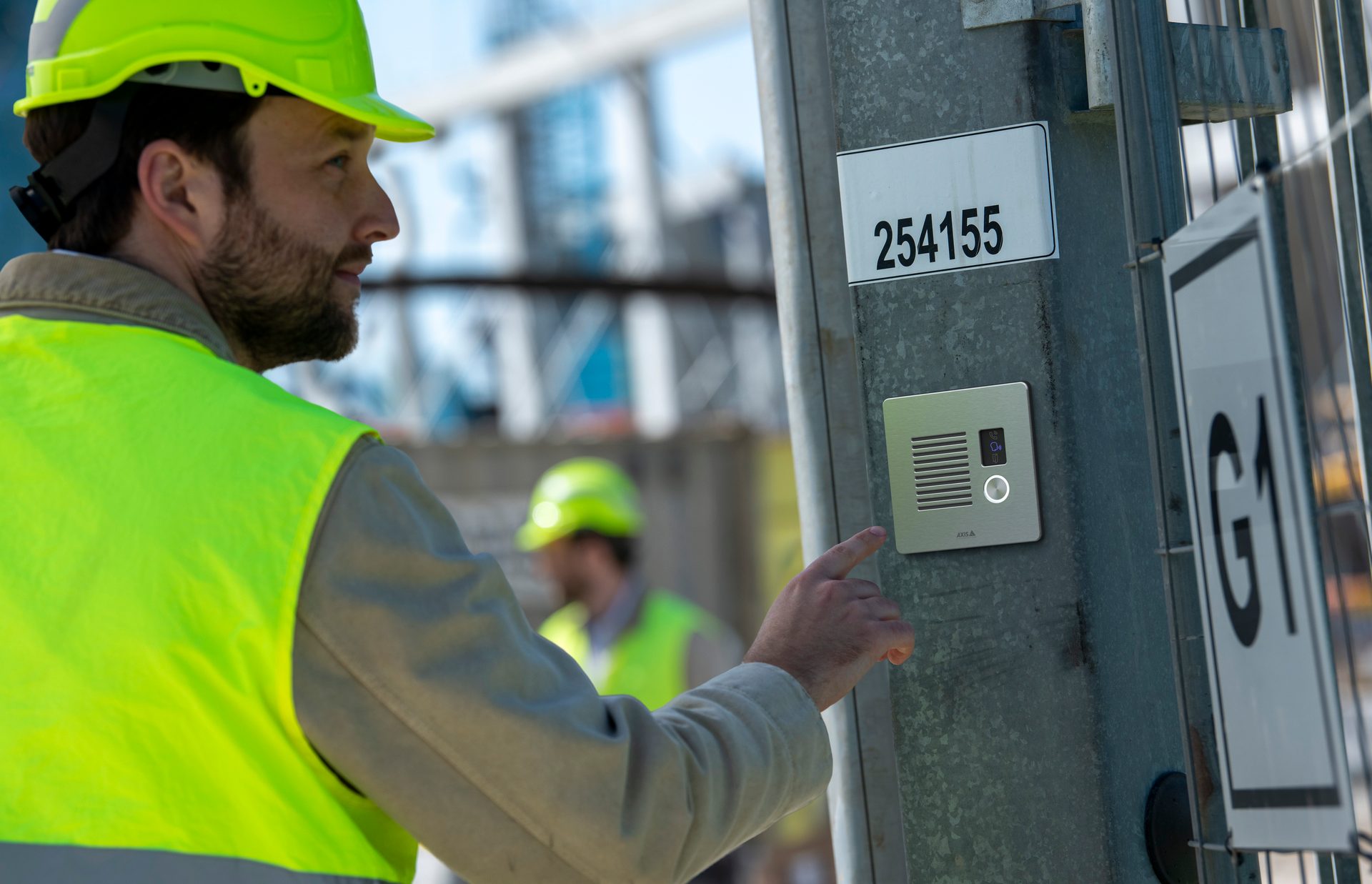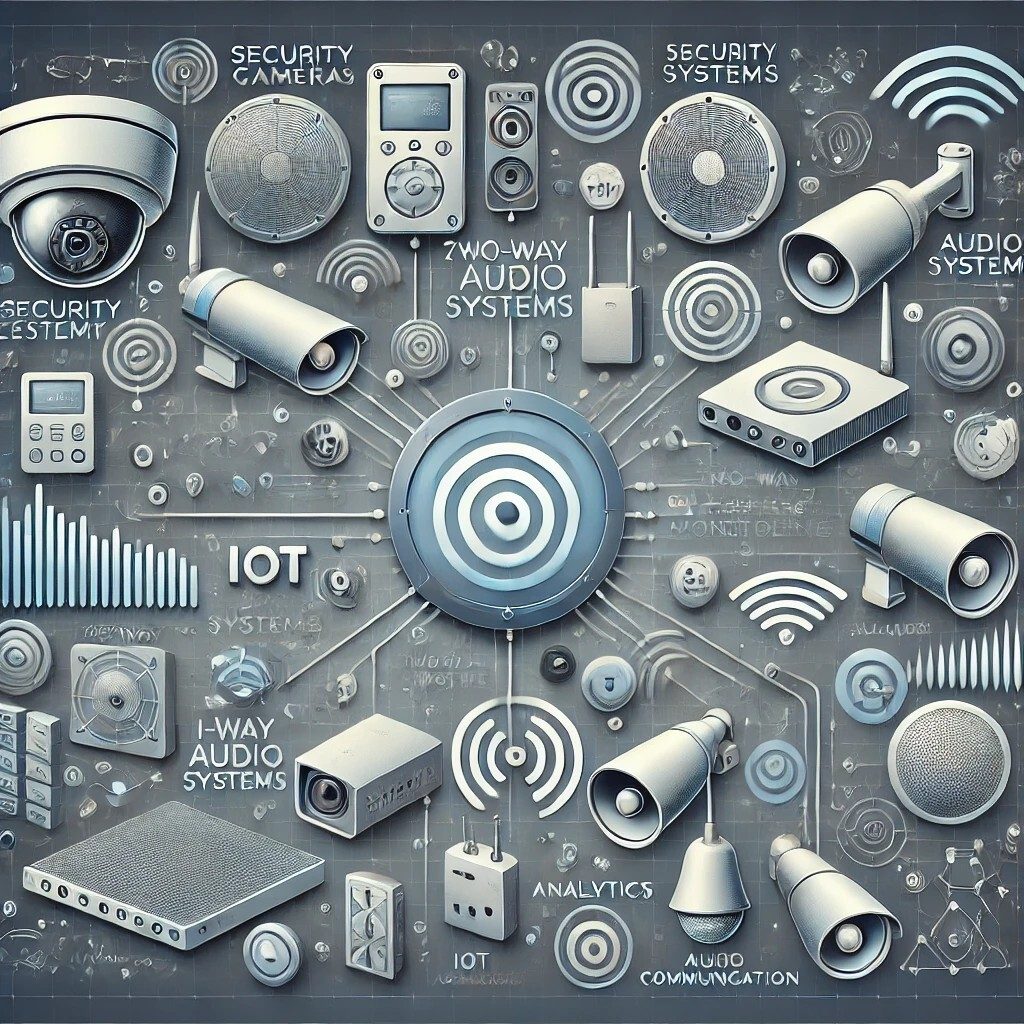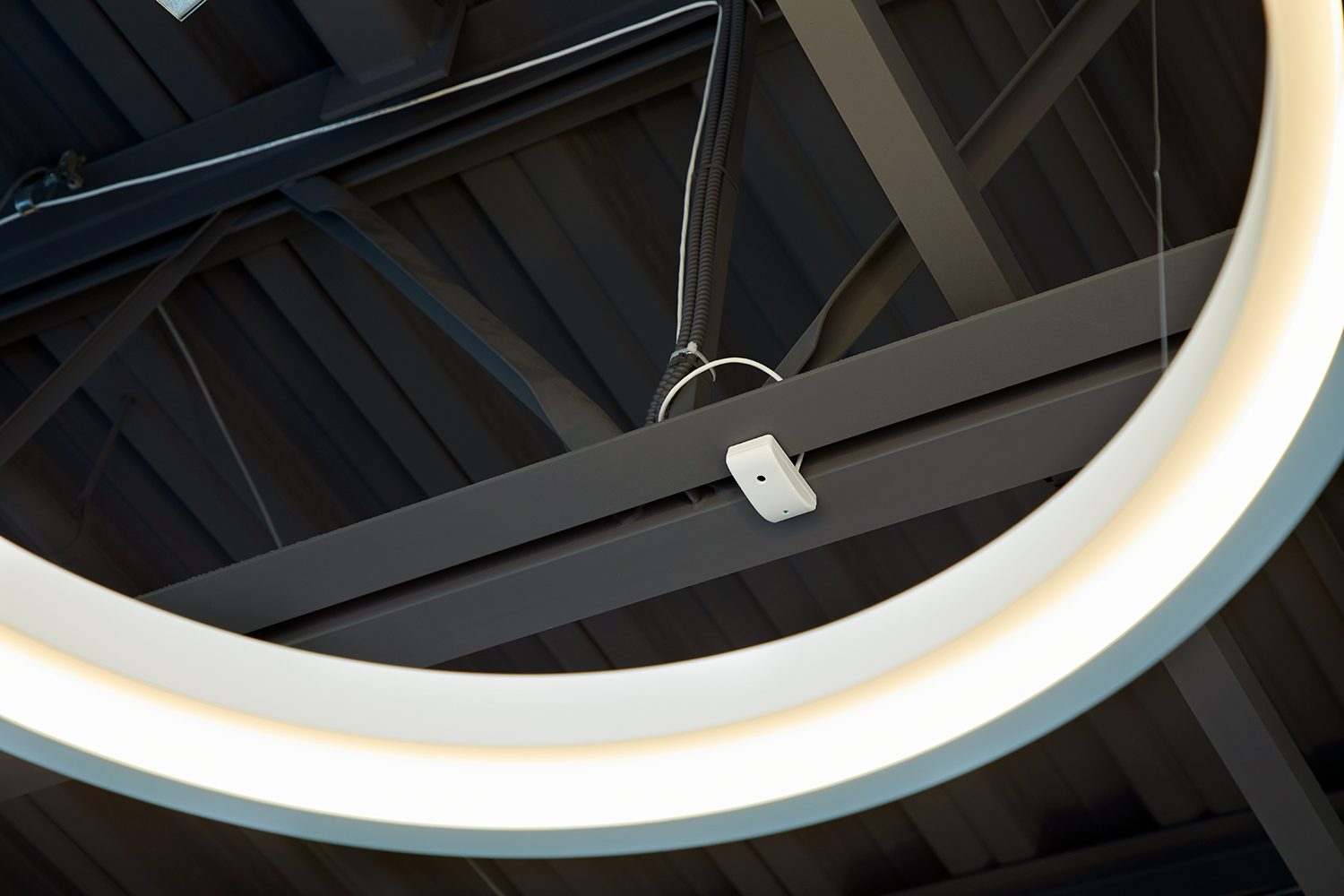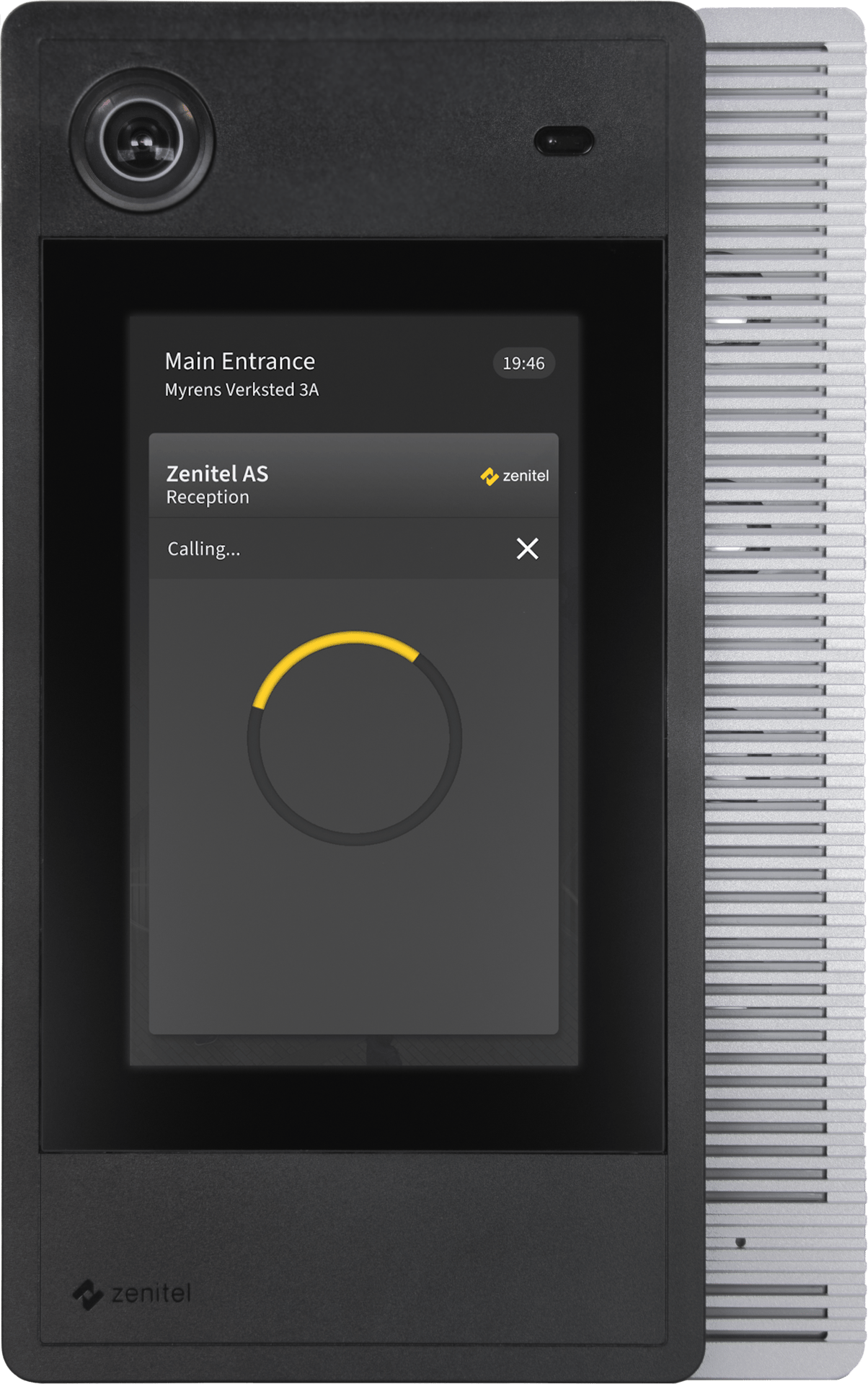may 2025
// Audio Solutions
Security Amplified: Audio’s Impact Speaks Volumes About Preventive Security
Audio is a powerful tool for crime prevention, especially when integrated with other solutions
By Laura Stepanek, SDM Contributing Writer

Many intercoms such as this one are easy to install using just one PoE network cable. The AXIS I7010-VE can seamlessly integrate with Axis and third-party VMS systems. It also supports Session Initiation Protocol (SIP) for IP phone system integration, as well as open programming interfaces for software integration, including VAPIX and ONVIF. Image courtesy of Axis
An experience that still may need more time to fade from the security industry’s collective memory is walking the aisles of an ISC show, watching glass-breakage detectors being demonstrated every 10 minutes. The piercing sound of the breaking glass, followed instantly by the high-pitched alarm and, often later, the formal noise complaints lodged with show management eventually led to the use of glass-encased, sound-proofed demonstrations in later shows.
It’s a memory that illustrates how far the security industry has come with audio technologies. Those ubiquitous glass-breakage detectors — employing acoustical sensing, vibration sensing, or a combination — still have a place in intrusion detection systems. However, today they are just one of a much wider range of solutions using audio to detect, deter and prevent crime.
Present-day audio devices not only generate alerts from sensors and intelligent analytics, they also support communication with speakers and intercoms, which improves the way security responds to situations. And as audio products become more capable of being integrated, they’re growing more powerful as time goes on.
In fact, a group at ONVIF is working on an audio standard to be released in the form of a profile for integration (see related sidebar). Audio products that in the past had to operate in a silo are now working in concert more often. Some manufacturers have solutions that bring these various products into unified platforms. This is a force multiplier for all of the ways that audio improves the functionality of security, especially in live remote monitoring applications.
Audio & Situational Awareness
“Audio adds another layer of security by offering situational awareness in ways that video alone cannot,” says Todd Keller, president of Speco Technologies, Amityville, N.Y. “Whether it’s using speakers to deter intruders or verifying incidents through audio alerts, having both sound and visual surveillance allows you to get the full picture. This approach strengthens security measures and improves response time.” Speco Technologies’ lineup of audio solutions, which seamlessly integrate with today’s security systems, use IP audio technology and AI-driven analytics to elevate communication capabilities and enable smarter, more proactive monitoring, Keller describes.
Audio helps complete a story, says Chris Wildfoerster, program manager, audio, Axis Communications, Chelmsford, Mass. “For example, is it two friends just joking around pushing each other, or is it a serious event where authorities need to step in? It’s important that audio really adds context to the actual video,” he says. In addition to its video and access control solutions, Axis has a wide range of open-platform, IP-based intercoms and audio products such as network speakers, audio management software, and more.
Audio technology changes the dynamic of a security system, making it proactive rather than simply reactive, Wildfoerster says. “Let’s say you’ve got somebody about to jump a fence. You have a camera on the fence and you have an analytic loaded in the camera — a cross-line deterrent. They cross that line and a message plays, ‘You’ve entered a secured area; please depart the way you came. Authorities have been notified.’
“That tells the person that the camera’s working. Because let’s face it — cameras are ubiquitous. You don’t know whether they’re working; you don’t know what the resolution is; you don’t know where they’re pointed; you don’t know if they’re monitored — you don’t know,” Wildfoerster says.
The audio component confirms that the camera is indeed working and the intruder is under surveillance, giving them the choice to either continue their course or retreat. “Audio really adds another dimension to a security system,” he affirms.
Dan Rothrock, senior vice president of global business development at Zenitel, Kansas City, Mo., says a security system consisting of access control and video is only reactive until you add audio. Adding audio takes a system from reactive to proactive, and beyond to interactive. “That changes everything,” Rothrock says, mentioning the well-known phrase, “If you see something, say something.”
Audio to Detect, Deter & Prevent
To reach the greatest potential in crime prevention, a system must go beyond simply recording video and triggering alerts, Rothrock says. “You have to interact with what’s going on there if you want to prevent crime. If the analytic in the camera sees something and turns the camera on, I can now pick up the signal from the video management system that also opens the audio path and I can speak to the person there. As soon as I do, it’s disruptive — I can talk about their behavior; they know somebody’s watching them. And in many, many cases instead of recording an event, you can mitigate an event,” Rothrock says.
Speco’s outdoor audio speaker has a built-in microphone for two-way communication and is connected to the SecureGuard Dashboard, which triggers alarms and sends real-time security alerts. The speaker also has a customer experience function: it can play music and share special messages with customers. Image courtesy of Speco

Audio can be a critical component of an overall security ecosystem. Whether it’s one-way audio to issue talk-down commands to loiterers or intruders or two-way audio for communication directly between a monitoring center and person(s) on site, audio devices can play a key role in creating better security outcomes. Image courtesy of Immix

Audio adds another layer of security by offering situational awareness in ways that video alone cannot.
— Todd Keller, Speco Technologies
Group Works Towards ONVIF Profile for Audio Devices
ONVIF, an organization that drives interoperability for IP-based physical security products, now has a working group for audio in security. The group’s efforts come at a time of increased interest in integrating products such as network speakers and intercoms with video and access control products, as well as monitoring and talk-down applications.
The members of the Audio Streaming Profile Working Group, which was announced in June 2024, are working to define an ONVIF profile for the interfaces and communications mechanisms for configuring and integrating audio speakers and other intercom devices. The group aims to create an audio standard, which will be released in the form of an ONVIF profile.
ONVIF currently offers Profile S for streaming video; Profile G for video recording and storage; Profile C for physical access control; Profile A for broader access control configuration; Profile T for advanced video streaming; Profile M for metadata and events for analytics applications; and Profile D for access control peripherals.
The group, which was founded in 2008 by Axis Communications, Bosch Security Systems, and Sony Corporation, today has a global base of members and more than 29,000 profile-conformant products.
The ability to warn perpetrators that they are being monitored highlights the effectiveness of audio as a powerful tool, Keller believes. In fact, he says studies show audio warnings reduce criminal behavior. Speco is one of several companies that sell solutions, such as its Digital Deterrent, that provide an obvious deterrent by combining video, detection analytics, speakers, even flashing lights — to deter potential threats before they escalate.
This particular combination of video recording with analytic-triggering of an event, followed by audio interplay, is most beneficial in preventing crime in restricted (fenced) outdoor environments, says Jason Caldwell, director of marketing and Guard Force accounts at Immix, Charlotte, N.C. “If somebody approaches that fence line and somebody using Immix gets the alarm, sees somebody there and makes that voice-down announcement before they ever start cutting into that fence, they’ve prevented potential theft and vandalism to the property. That is really what audio is designed to do,” Caldwell says.
The Immix platform, which is designed to be used directly by an end user or by a central station, connects varied systems including up to a dozen different audio technology providers’ products. The company has more than 500 technology partners.
Caldwell says 75 percent of Immix users deploy what it calls video detection and response. The camera system serves as the “alarm system,” with AI-based analytics triggering alerts to specific human or vehicle changes. Audio is an essential element for the deterrence work, because without it an operator needs to contact police, who may or may not arrive in time to prevent a crime from occurring, he explains.
“If you have that audio component, your first line of security is there,” Caldwell says. “And in most cases, you’re going to stop that activity in its tracks and prevent something from escalating or happening at all. It’s a proven solution. That particular combination of video with audio talk-down deterrent is the most popular application that Immix users deploy.”
In fact, not only for Immix users but for end users generally, this is one of the most popular applications in the market now.
Outdoor applications consist of IP audio speakers installed at various points on a property. Speakers can be addressed individually or zoned together so that a single announcement can broadcast through all speakers. Messages may be spoken by a live operator or delivered as prerecorded. Some products offer a selection of prerecorded messages, such as one that’s polite and friendly, one that’s slightly more urgent, and one that warns of authorities being contacted, Caldwell says.
The ability to broadcast prerecorded messages, especially to multiple speakers, helps reduce operator training and the time needed to make announcements as well as overcome any inconsistencies in the messaging, says Erin Bullard, director of partner relations at Immix.
A distinction worth considering is whether an end user will need speakers with one-way or two-way audio communication. One-way audio is commonly referred to as “talk-down,” while two-way is sometimes called “talk-back” or inbound audio.
“I think the inbound audio is something that maybe doesn’t get enough credit in terms of how it’s used within monitoring, but it is something that we see a lot of with our customers and it’s very valuable,” Bullard says.
For example, in retail environments, especially at convenience stores, inbound audio can be helpful during duress situations, she says. Operators can use it to listen to situations without responding so as not to escalate a potentially violent scene before first responders arrive.
And in emergency situations in classrooms, bidirectional communication through speakers allows “not just directions out, but information gathered back in,” Rothrock adds.
While many audio-based security solutions rely on sound to produce a deterrent effect, one company relies on sound to maintain silence — and that ultimately helps them make apprehensions. Founded in 1964, Sonitrol is one of the earliest audio-based security solutions in the industry. Although the technology has been updated, the core solution hasn’t changed, remarks Julie Beach, vice president of Sonitrol, Pacom, and customer support, based in Fishers, Ind.
Sonitrol’s patented impact-activated audio sensors are installed throughout customers’ premises. When the site is armed, these sensors actively listen for sounds such as breaking glass, banging, or similar noises that indicate an intrusion. They then begin streaming the audio to a central station for operators to listen to. “That allows us to be able to verify the alarm and be able to call the dispatch and let them know that we have a verified audio intrusion alarm, which then qualifies [for] priority police response,” Beach says.
Central station operators do not have the means to listen to audio at a customer’s site on-demand. The system begins streaming audio only when it is armed and after it hears an impact sound that activates the sensor, she describes.
Because Sonitrol systems are focused on apprehensions and preventing customers from experiencing loss, the alarms are silent. When they activate the alarm, intruders don’t usually know that they’ve been detected, giving the central station time to relay the breach to authorities as well as a better idea of what they’re walking into, she says.
To date, Sonitrol has 187,000 documented apprehensions since it first started tracking them in 1977. Beach says that 20 percent of apprehensions have occurred before the intruder gained entry into the building, making it an effective crime prevention system. She emphasizes the “floor to ceiling, wall to wall” volumetric coverage that the Sonitrol system and audio in general provide.
The patented SONITROL Audio Sensor is used to detect attempted intrusion through impact-activated audio and glass break analytics. This device captures the unique intrusion sounds of a secured facility, which are then analyzed and verified in real time by highly trained central station personnel. Image courtesy of Sonitrol

The brand new Zenitel Display Door intercom (ZDD-1) features a speaker and microphone array to deliver an immersive sound experience, and bi-directional video communication to enable face-to-face interaction. With ONVIF compatibility, they seamlessly integrate with surveillance systems, providing an additional layer of security for effective identification and entry control. Image courtesy of Zenitel

There is now, from the end user side, an expectation of having audio on their project just as they would expect to have video and access control. So the demand and where the decision is made is starting to change and they are no longer siloed — they are expected to be interoperable.
— Dan Rothrock, Zenitel
Audio Integrations
Just as with other security technologies, the world of audio devices is trending towards integration on a single platform. As technology advances, it gives way to more choices — and with more choices comes the need for an open platform to host best-of-breed devices from different manufacturers.
Modern audio analytics, for example, not only can alert users to glass breakage but even tell them what type of glass broke. They can detect the sound of a person coughing uncontrollably. They can alert to the sounds of someone becoming stressed or irate, the sounds of screaming and shouting, as well as the sounds of gunshots. As the landscape of solutions broadens, it gives end users more choices but also challenges them with a greater need for integration.
“There is now, from the end user side, an expectation of having audio on their project just as they would expect to have video and access control,” Rothrock says. “So the demand and where the decision is made is starting to change and they are no longer siloed — they are expected to be interoperable.” He describes how the open concept is one of the key drivers of Zenitel’s platforms, including: IC-EDGE, ICX-Alphacom enterprise solution; and the newest Zenitel Connect Pro.
As Immix works to create a comprehensive monitoring experience for its customers, its platforms are increasingly being called upon to handle unique solutions in addition to traditional ones. For example, Bullard mentioned an audio application that Immix was involved with recently, featuring Halo Smart Sensors, devices that were created by IPVideo, now a part of Motorola Solutions. The sensors are preconfigured with five keyword phrases, which, when spoken by someone in distress, will send notifications to people who have been designated to receive the alerts.
“I think that is very powerful, especially in K-12 education and in hospitals, because it’s not something that you have to be next to a button to push,” Bullard describes. “A teacher could say this word from across the room. You can change the word every so often and you can trigger that alarm, and unbeknownst to whomever the perpetrator is, have somebody backing up that situation.”
Having audio on an IP network opens up “a whole new realm of interoperability and integrations that you don’t necessarily have in the analog world — or it’s not as easy,” explains Dom Albano, program manager, intercoms, at Axis Communications. On a simple level, a network-connected intercom does things like let users power a door lock from the intercom as well as wire a door sensor that lets them see when a door may be propped open and perhaps play a message that requests somebody nearby close the door. They also could wire a request-to-exit button directly to the intercom to release the door. “So you can have everything integrated all in this one device. These can also talk over the IP network to a separate door controller or access control system if that’s wired there,” Albano says.
You could also have a video analytic on that intercom, triggering different audio aspects or notifying people. For example, the intercom with built-in camera could detect somebody loitering and then that could send a notification to security or automatically trigger the intercom to call security, producing a live connection through which security can talk down, he says.
“Or you have a deterrent, where it’s after hours and nobody should be hanging out at the school at midnight, and it detects someone loitering or approaching the intercom,” Albano says. “Now it can just trigger a pre-recorded audio message to play — and this could be on the IP speakers, as well — saying, ‘Security has been alerted to your presence; you’re being recorded.’”
Albano says the Axis operating system contains the Axis Camera Application Platform (ACAP), which enables the loading of either Axis analytics or third-party analytics on the edge. With edge processing, the system can trigger different notifications right from the device, whether it’s a speaker or an intercom. “It’s just like loading an app into your cell phone; you load an app onto the Axis device to give it that extra boost for the analytics,” Albano describes.

Axis network speakers are complete audio systems in a single unit. The portfolio features ceiling speakers, cabinet speakers, pendant speakers, mini speakers like this one, a sound projector, and others. Image courtesy of Axis
SIA Resource: A Primer on Audio
“Hearing is believing,” writes the Security Industry Association (SIA) in its informational guide, “Safe and Sound: A Primer on Audio and Intelligent Communications Applications for Security.”
Published in 2021 by SIA’s Audio and Intelligent Communication’s Working Group, the guide explains how the dynamics of audio and voice communications are changing and fitting into more security solutions. “In a security setting, sound that accompanies video gives responders so much more information and creates better situational awareness,” the guide describes.
The information illustrates how audio can act as a “force multiplier” when integrated into a security system, where it works to enhance safety, security and business operations. Audio can help de-escalate situations, preventing them from scaling into major events, the primer explains.
“Safe and Sound” provides readers with a brief history of the use of audio in security, as well as a round-up of it benefits: response time improvement, improved situational awareness, operational efficiencies and business optimization, false alarm minimization, and return on investment. It also provides an overview of technologies and how to select an appropriate audio solution, such as an external microphone or an intercom.
The SIA audio guidebook should be a valuable addition to security integrators’ educational programs.
Because of ONVIF interoperability standards, an intercom on the outside of a building can connect to a video management system. And since ONVIF Profile T includes two-way audio, the intercom with the video camera can communicate with the VMS and even call security. “I could use SIP, I could use ONVIF, I could use custom APIs or custom language to talk to the intercom,” Albano emphasizes. “There are many different ways you could do it. There’s a lot of flexibility once we open up the IP world."
Another solid example of the variety that integration brings to audio security is a car dealership application, says Wildfoerster of Axis. In this installation, cameras are installed on light poles, along with a horn and a strobe. Around closing time at 9 p.m., if people are still on the lot, an automated message plays, saying, “We’re closing soon. Please come back during our regular business hours.”
It’s commonly referred to as a loitering analytic. But if someone were detected there at midnight, a strobe may be triggered and the recorded message would be something like, “We’re closed. Please come back during operating hours.” And if the person stays there for another couple of minutes — and if the system is being live-monitored — then the strobe flashes and a security officer or central station operator announces, “Authorities are on their way. Please leave.”
“It’s phenomenal the impact that has on the folks that are there,” Wildfoerster says.
A brand-new Axis product in this category is the AXIS D4200-VE. It’s an all-in-one strobe and speaker that comes with AXIS Audio Analytics pre-installed and enables live and pre-recorded audio and alarm sounds. The strobe functions in nine different colors and users can program 22 different patterns to play out. “So you not only get audio, but you also get the visual impact of the strobe,” Wildfoerster says.
Axis network speakers feature a very simple configuration of a PoE category cable from the switch to the speaker. The manufacturer has a family of software configuration tools called Axis Audio Manager, consisting of three levels. The first is AXIS Audio Manager Edge, which is built-in to every speaker and has configuration capabilities for up to 200 speakers, 20 zones, multiple levels of priority, weekly scheduling, and health monitoring. AXIS Audio Manager Pro is for larger and more complex systems; and AXIS Audio Manager Center is a cloud-based system that allows users to maintain locations globally.
Keller says audio talk-down systems such as Speco’s and advanced audio analytics enable security teams to respond faster. “Whether it’s using speakers to deter intruders or verifying incidents through audio alerts, having both sound and visuals surveillance allows you to get the full picture. This approach strengthens security measures and improves response time,” he says.
Audio not only provides a clear benefit to security end users, but presents a revenue opportunity for security integrators. As people have become comfortable interacting with audio in their homes, vehicles and elsewhere in daily life, that trend is carrying over to the workplace and other commercial facilities, where audio is expected to be part of the security ecosystem. And bottom line — it has proven to be a very effective crime prevention tool.

